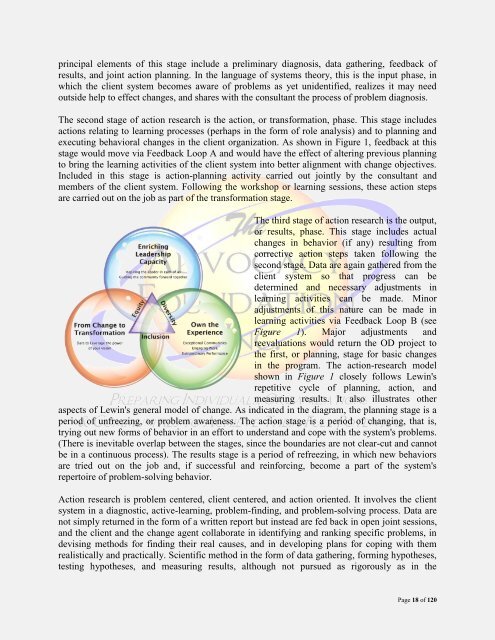Organizational Development - Vol. V, Part II
Organizational Development - Vol. V, Part II
Organizational Development - Vol. V, Part II
Create successful ePaper yourself
Turn your PDF publications into a flip-book with our unique Google optimized e-Paper software.
principal elements of this stage include a preliminary diagnosis, data gathering, feedback of<br />
results, and joint action planning. In the language of systems theory, this is the input phase, in<br />
which the client system becomes aware of problems as yet unidentified, realizes it may need<br />
outside help to effect changes, and shares with the consultant the process of problem diagnosis.<br />
The second stage of action research is the action, or transformation, phase. This stage includes<br />
actions relating to learning processes (perhaps in the form of role analysis) and to planning and<br />
executing behavioral changes in the client organization. As shown in Figure 1, feedback at this<br />
stage would move via Feedback Loop A and would have the effect of altering previous planning<br />
to bring the learning activities of the client system into better alignment with change objectives.<br />
Included in this stage is action-planning activity carried out jointly by the consultant and<br />
members of the client system. Following the workshop or learning sessions, these action steps<br />
are carried out on the job as part of the transformation stage.<br />
The third stage of action research is the output,<br />
or results, phase. This stage includes actual<br />
changes in behavior (if any) resulting from<br />
corrective action steps taken following the<br />
second stage. Data are again gathered from the<br />
client system so that progress can be<br />
determined and necessary adjustments in<br />
learning activities can be made. Minor<br />
adjustments of this nature can be made in<br />
learning activities via Feedback Loop B (see<br />
Figure 1). Major adjustments and<br />
reevaluations would return the OD project to<br />
the first, or planning, stage for basic changes<br />
in the program. The action-research model<br />
shown in Figure 1 closely follows Lewin's<br />
repetitive cycle of planning, action, and<br />
measuring results. It also illustrates other<br />
aspects of Lewin's general model of change. As indicated in the diagram, the planning stage is a<br />
period of unfreezing, or problem awareness. The action stage is a period of changing, that is,<br />
trying out new forms of behavior in an effort to understand and cope with the system's problems.<br />
(There is inevitable overlap between the stages, since the boundaries are not clear-cut and cannot<br />
be in a continuous process). The results stage is a period of refreezing, in which new behaviors<br />
are tried out on the job and, if successful and reinforcing, become a part of the system's<br />
repertoire of problem-solving behavior.<br />
Action research is problem centered, client centered, and action oriented. It involves the client<br />
system in a diagnostic, active-learning, problem-finding, and problem-solving process. Data are<br />
not simply returned in the form of a written report but instead are fed back in open joint sessions,<br />
and the client and the change agent collaborate in identifying and ranking specific problems, in<br />
devising methods for finding their real causes, and in developing plans for coping with them<br />
realistically and practically. Scientific method in the form of data gathering, forming hypotheses,<br />
testing hypotheses, and measuring results, although not pursued as rigorously as in the<br />
Page 18 of 120

















